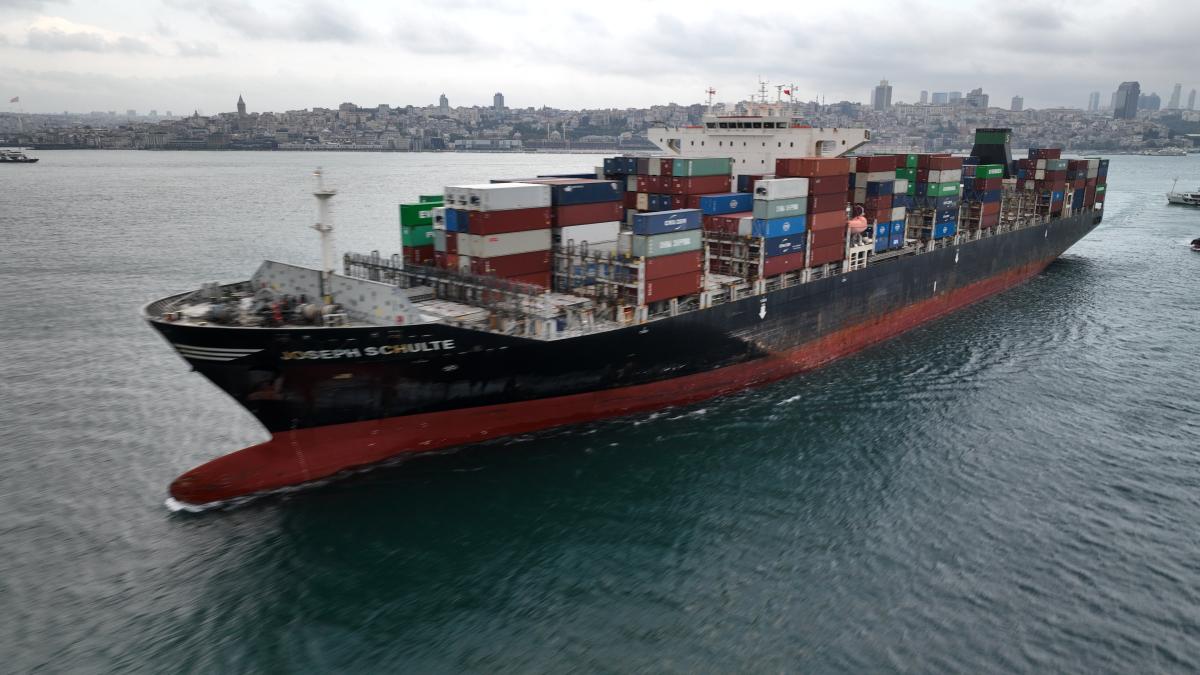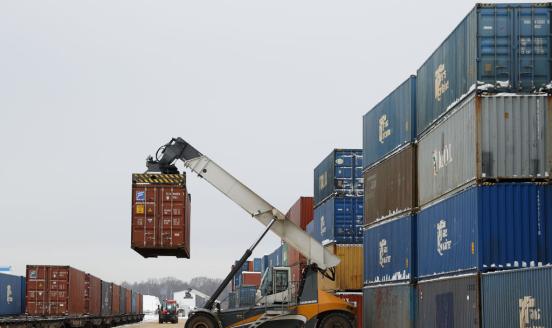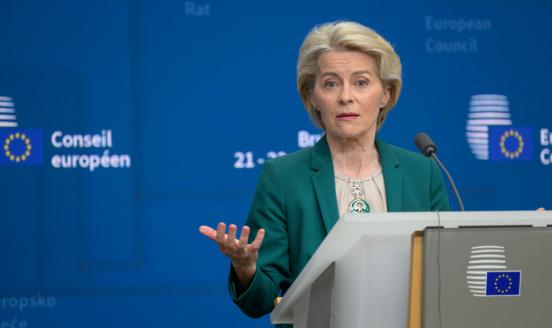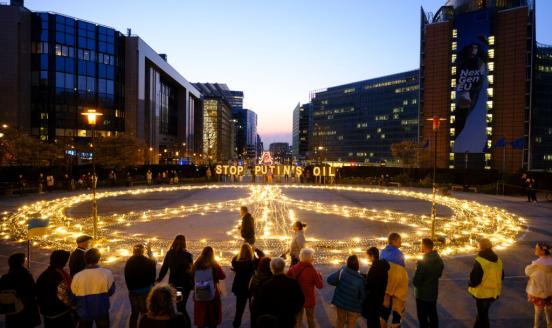Emerging countries have replaced most of Russia’s lost trade with advanced economies
Russian trade overall seems to have suffered little from sanctions; meanwhile, medicine and food trade continues with sanctioning countries

Russia’s trading relationships have changed hugely since its full-scale invasion of Ukraine two years ago. Most advanced countries now restrict exports to and imports from Russia, while several companies headquartered in advanced countries reduced their activities in, and trade with, Russia. However, many emerging countries, most notably China, have deepened their economic ties with Russia. What is the net impact of these diverging trends?
Exports to Russia
For goods overall, Russia’s share as a destination country for global exports has declined, from an average of 1.39 percent in 2017-2019 to 1.17 percent on average from September 2022 to October 2023 (Figure 1)
1
For all calculations in this analysis, we excluded intra-EU trade andconsidered the EU as a single economic area in global trade flows. Intra-China and intra-US trade are not included in global trade figures either.
. The latest 1.03 percent share in October 2023 is the lowest since autumn 2002 if the immediate aftermath of the February 2022 invasion is excluded. Thus, Russia as a market has lost share, and emerging and developing countries have only partly replaced the goods that advanced countries no longer export to Russia.
Russia’s role is particularly unique in EU and Chinese exports (Figure 1). After Russia’s economic crisis in the late 1990s, it integrated gradually with the EU and its share of exports leaving the EU increased from about 2 percent in 1999 to over 7 percent by 2007. The global financial crisis resulted in a temporary setback. Major drops followed the annexation of Crimea in 2014 and the full-scale invasion in 2022. Nevertheless, the EU continues to send 1.4 percent of its extra-EU exports to Russia.
Meanwhile, Russia’s share of Chinese exports has increased notably since the initial trade collapse following the invasion. Even after a setback from summer to autumn 2023, the latest 3 percent share is well above the close to 2 percent share that characterised the pre-invasion years.
The composition of exports to Russia
We study the composition of foreign trade for those 38 countries included in Bruegel’s Russian foreign trade tracker (Darvas et al, 2022). These countries accounted for 80 percent of Russia’s goods exports and imports in 2019. We separate countries that imposed sanctions following Russia’s full-scale invasion of Ukraine (27 EU countries, Japan, Norway South Korea, Switzerland, the United Kingdom and the United States), and countries that have not (Brazil, China, India, Kazakhstan, Turkey).
Exports to Russia by sanctioning countries dropped dramatically following the full-scale invasion (Figure 2a). From January 2019 to February 2022, these exports averaged $10.5 billion a month, which more than halved to $4.6 billion in 2023, a reduction of $5.9 billion/month. This fall was largely driven by a drop in exports of machinery and transport equipment (SITC category 7), which fell from a monthly average of $4.9 billion to $1.1 billion over the same period.
Exports from non-sanctioning countries were increasing steadily even before the invasion, and have sustained elevated levels since August 2022, following an initial drop (Figure 2b). On average, from January 2019 to February 2022, non-sanctioning countries exported goods worth $6.0 billion per month to Russia, which rose to $11.5 billion, an increase of $5.5 billion/month. This increase falls just marginally short of the reduction in exports from sanctioning countries.
Interestingly, the increased exports from non-sanctioning countries are driven largely by machinery and transport equipment, a mirror image of the declining exports from sanctioning countries.
Digging deeper into the composition of trade in machinery and transport equipment (Figure 3), we find that some categories for which the drops from sanctioning countries were not fully replaced by non-sanctioning countries (such as category 78: road vehicles), while others were more or less replaced fully (74: general industrial machinery, and 72: machinery for specialised industries). There are also items for which reduced exports from sanctioning nations have been overcompensated by non-sanctioning countries (71: power-generating machinery and equipment).
The increase in exports of machinery and transport equipment to Russia by non-sanctioning countries is particularly concerning since several sanctioned goods fall into this category. An increase in such exports could reflect trade diversion (eg Russia now purchases Chinese products instead of EU products) and sanctions evasion (eg EU exports to Kazakhstan, which are then re-exported from Kazakhstan to Russia).
There is evidence that Russia receives sanctioned goods through both these channels (see Astrov et al, 2024; Bergmann et al, 2023; Bilousova et al, 2024; Bilousova et al, 2023; Borin et al, 2023). Borin et al (2023) reported that about 10 percent of the fall in EU-restricted exports to Russia in the fourth quarter of 2022 might have been re-routed through third countries to Russia: the decline in such EU exports to Russia was $7.5 billion, while they estimated the potential re-routing of EU-restricted products at $760 million
2
The lower value between the increase in exports from the EU to potential hubs and the increase in exports from potential hubs to Russia.
. They noted that other ways of evading sanctions are also possible but difficult to quantify. For example, products exported by the EU and destined for third countries according to EU customs data may be instead shipped to Russia without even being recorded in third countries’ imports – a phenomenon called ‘ghost trade’. They confirmed evidence of such trade at aggregate level, but when using more granular data, they reported that the increase in discrepancies is similar for both sanctioned and non-sanctioned products, and thus called for further investigation of the factors that could contribute to such discrepancies.
The detailed list of products subject to export bans is very extensive and we do not have access to data on each sanctioned product. Therefore, we selected five broader categories, which include sanctioned products but also include non-sanctioned products (Figure 4).
Total monthly exports from the 38 countries of these categories to Russia averaged $2.4 billion from January 2019 to February 2022, and are yet to recover from the decline following the invasion. The average monthly export value of the categories in 2023 was $1.8 billion. The steep decline in exports from sanctioning countries was accompanied by an increase in exports of the same goods from non-sanctioning countries. While monthly data is volatile and could also reflect seasonal effects, in December 2023 the exports of such products from non-sanctioning countries was on the rise.
The EU and others have not imposed sanctions on all goods. In Figure 2a, chemicals and agricultural products are two major categories for which significant changes have not been seen in exports from sanctioning countries following the invasion.
Among chemical products, the dominant category is medicinal and pharmaceutical products, which continue to flow from Western nations to Russia in large quantities, largely exceeding what non-sanctioning countries send (Figure 5). This is good news. The goal of the sanctions is to compromise Russia’s ability to wage the war, and not to deprive the Russian people of medicines.
The same can be said about agricultural products exported from the West to Russia. This trade has not been disrupted by the full-scale invasion of 2022, helping some Western farmers to keep their markets (Figure 6).
However, the stability of EU agricultural exports to Russia from 2019-2023 should be put into the context of a major earlier decline. In 2014, Russia introduced far-reaching agri-food import bans in response to countries imposing sanctions following the illegal annexation of Crimea. These sanctions affected products of which the EU was a major supplier (dairy, fruit, vegetables and meat; see McEldowney, 2016). In US dollar terms, EU27 agri-food exports to Russia declined by 68 percent from 2011-2013 to 2015-2017, on average, while the decline was 90 percent for the United States.
Imports from Russia
Imports from Russia by sanctioning countries fell in every main category from the monthly average of January 2019-February 2022 to the monthly average of 2023 (Figure 7). The various import bans on Russian fossil-fuel products (Darvas and Martins, 2022) resulted in a dramatic reduction of such imports by sanctioning countries. Parallel to that, imports of Russian fossil fuels by non-sanctioning countries increased, most notably China and India (see McWilliams et al, 2024, for an analysis).
The second main import item for Western nations before the war was material manufactures, imports of which fell from $2.6 billion per month in January 2019 – February 2022 to less than $1 billion in 2023.
Altogether, total imports from Russia by sanctioning countries fell by $12.4 billion in January 2019-February 2022, while the increase by non-sanctioning countries fell just marginally short of compensating for this drop, at $12.0 billion.
Summary
Russia’s full-scale invasion of Ukraine in February 2022 has resulted in a major diversion of Russian trade. The coalition of western sanctioning countries significantly reduced trade with Russia, while non-sanctioning emerging countries, most notably China, India and Turkey, have greatly expanded trade with Russia. So far, this increase has not entirely replaced the shortfall from loss of trade with sanctioning countries, but it is close to doing so, and if the trend continues to rise, may soon fully make up the shortfall.
Meanwhile, not all exports to Russia by sanctioning countries collapsed after the 2022 invasion. The main exceptions are chemicals – dominated by medicines – and agricultural products.
References
Astrov, V., F. Teti, L. Scheckenhofer and C. Semelet (2024) ‘Russia’s Economy on the Eve of the Second Anniversary of the War’, wiiw Russia Monitor 4, February, available at https://wiiw.ac.at/russia-s-economy-on-the-eve-of-the-second-anniversary-of-the-war-dlp-6811.pdf
Bergmann, M., M. Snegovaya, T. Dolbaia and N. Fention (2023) Out of Stock? Assessing the Impact of Sanctions on Russia’s Defense Industry, Center for Strategic and International Studies, available at https://csis-website-prod.s3.amazonaws.com/s3fs-public/2023-04/230414_Bergmann_Out_Stock.pdf?VersionId=6jfHCP0c13bbmh9bw4Yy2wbpjNnfeJi8
Bilousova, O., O. Gribanovskiy, B. Hilgenstock, E. Ribakova, N. Shapoval and V. Vlasiuk (2023) Russia’s Military Capacity and the Role of Imported Components, Yermak-McFaul International Working Group on Russian Sanctions & KSE Institute,available at https://kse.ua/wp-content/uploads/2023/06/Russian-import-of-critical-components.pdf
Bilousova, O., B. Hilgenstock, E. Ribakova, N. Shapoval, V. Vlasyuk and V. Vlasiuk (2024) Challenges of Export Controls Enforcement, Yermak-McFaul International Working Group on Russian Sanctions & KSE Institute, available at https://kse.ua/wp-content/uploads/2024/01/Challenges-of-Export-Controls-Enforcement.pdf
Borin, A., G. Cappadona, F.P. Conteduca, B. Hilgenstock, O. Itskhoki, M. Mancini, M. Mironov and E. Ribakova (2023) ‘The impact of EU sanctions on Russian imports’, VoxEU, 29 May, available at https://cepr.org/voxeu/columns/impact-eu-sanctions-russian-imports
Darvas, Z. and C. Martins (2022) ‘The impact of the Ukraine crisis on international trade’, Working Paper 20/2022, Bruegel, available at https://www.bruegel.org/working-paper/impact-ukraine-crisis-international-trade
Darvas, Z., L. Léry Moffat, C. Martins and C. McCaffrey (2022) ‘Russian foreign trade tracker’, Bruegel Datasets, first published 10 October 2022, updated on 20 February 2024, available at https://www.bruegel.org/dataset/russian-foreign-trade-tracker
McEldowney, J. (2016) ‘The Russian ban on agricultural products’, Briefing, European Parliamentary Research Service, available at https://www.europarl.europa.eu/RegData/etudes/BRIE/2016/581971/EPRS_BRI(2016)581971_EN.pdf
McWilliams, B., G. Sgaravatti, S. Tagliapietra and G. Zachmann (2024) ‘The European Union-Russia energy divorce: state of play’, Analysis, 22 February, Bruegel, available at https://www.bruegel.org/analysis/european-union-russia-energy-divorce-state-play



